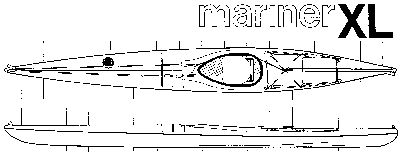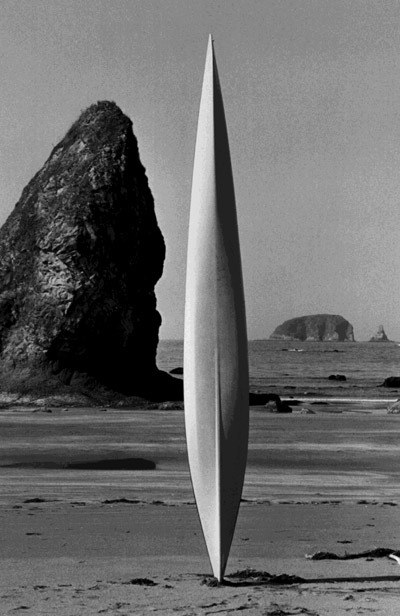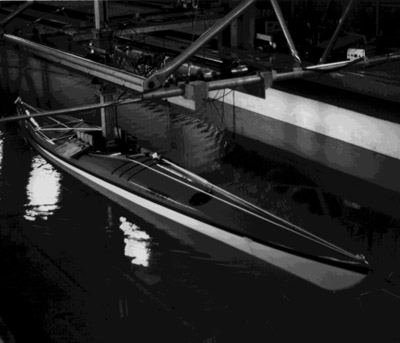Dogma falls to relentless design assault. Having our cake and eating it, too, is one major objective whenever we sit down to design a new sea kayak. Any entrenched dogma that insists "you can't" serves as a challenge to our imagination. Our efforts are doubly rewarded: not only do we have the satisfaction of achieving a goal, we get to paddle the result!Consider some of the features of the Mariner XL. It tracks positively and yet turns with a minimum of fuss. It paddles easily like a narrow boat, but is reassuringly stable when conditions get rough. The cockpit offers a secure and solid fit even though it is also comfortably roomy and convenient. How is all this possible? Let's look at the cockpit first. The opening is fairly long. You can lift your knees if you want. You can get in and out quickly and with ease, putting your feet in or out while seated inside. It's much more comfortable and convenient than a tiny cockpit, but not less secure. The XL's spray deck has no problem staying in place under a dumping wave. Padded kneebraces at the sides of the cockpit and a seat with plenty of side support allow you to lock yourself in the XL whenever necessary for positive boat control or Eskimo rolling. Our knee braces are molded in--an integral part of the deck itself--not glued in later or entirely absent as on many others. There is just no way our kneebraces can break or fail in a critical situation. The XL is a mover. Fine entry and ideal distribution of buoyancy help you make the most of your energy output. It cuts through the water like a narrow boat because it IS--at the waterline. But above the water the sides flare out to a greater maximum beam for a high degree of secondary stability. Combine this with the hard chines and you get a reassuring steadiness in the real world of waves, swells and chop. The XL is stable and forgiving when you need it most.
Flip the XL over and examine it closely. Notice the "runner", that slight protrusion of the keel that begins at the cockpit and extends back toward the stern. This unique Mariner feature holds the kayak solidly on line while under way, without seriously retarding the turning ability as would placing the maximum keel at the stern as is done on other kayaks for firm tracking. And in waves and swell, unlike a stern keel, rudder or stern mounted skeg, the runner is always in the water doing its job. But when it comes time for you to turn, the forward location of this runner and the rockered keel at both ends means less leverage to overcome. The Swedeform shape, with its maximum curve and width aft, along with the hard chines that become curved keels with a slight lean, make the XL easy to turn. We call this effect our "integral rudder." And this means course corrections required by wave action take far less work. There's lots more. A bow that rises smoothly and settles back gently into the waves without pounding (or throwing much water into the air for the wind catch and spray onto you). An incredible paddling ease to cargo capacity ratio. Top quality construction and careful detailing. Flowing lines and elegant good looks. The Mariner XL was reviewed by Sea Kayaker magazine. Click on XL Review here or open the "Reviews" menu in the sidebar.
Comparing all six kayaks that were accurately measured in a towing tank by Sea Kayaker (reported: Winter 86 and Spring 87) the XL had 9% less drag at a four knot cruising speed than the next best, and 18% less drag than one. To those that doubt the accuracy of those tests all the retests done with the same kayaks at the same speeds were within one percent of each other and at three knots the XL’s numbers were 7% and 14% easier. A closer look at the previous pictures may help you understand why. Notice the long entry that gently parts the water. In the tow tank picture notice the long straight waterline that widens gradually and evenly. The XL above (that has 250 pound of weight added) is barely making a bow wave at four knots. The flared sides and reserve buoyancy in the bow and stern contribute not only to a dry deck and large storage capacity, but to an awesome secondary stability. Sea Kayaker found (Spring 87) the Mariner XL could be leaned further before capsizing than all but one of the ten other sea kayaks tank tested. Quite astounding considering the XL was within 1/4" of having the narrowest waterline beam in the group--some kayaks with waterlines almost 3" wider capsized sooner. The narrowest kayak in the group capsized 15 degrees sooner and one kayak that was over 2" wider capsized at 10 degrees less lean). Hull Configuration and Features:
© 1999 Mariner Kayaks |


